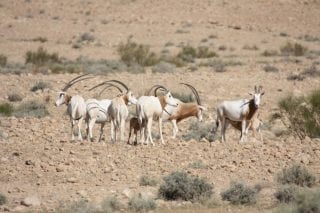Fun Facts
Eyes
Scimitar-horned oryx have dark patches around their eyes. This helps to keep the glare from the sun out of their eyes. They also have thick eyelashes and strong eyelids that help protect against windblown sand.
Horns
Scimitar-horned oryx use their horns to have pushing matches between males for mates. To keep them from slipping, they have 'grips' on their horns, closer to their skull. This helps males to compete with each other without running the risk of getting hurt.
Saving water
Scimitar-horned oryx have adaptations for coping with the shortage of water in their hot desert and savanna environments. They get much of the water they need from the plants they eat, but can go for long periods without drinking water. They are also able to raise their body temperature by several degrees, meaning they do not need to sweat as much, which in turn conserves water.
Unicorns
There are many origin stories for unicorns, and the anatomy of the scimitar-horned oryx is one of them. It is said that sightings of scimitar-horned oryx inspired some of the stories of unicorns. This may have been due to sightings of injured one-horned oryxes or the fact that from certain angles, scimitar-horned oryxes can look like they have only one horn.


